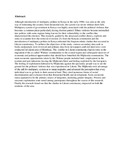| dc.description.abstract | Although introduction of multiparty politics in Kenya in the early 1990s was seen as the only way of redeeming the country from dictatorial rule, the system was never without short falls. Multiparty system of government in Kenya was highly associated with the political violence that becomes a common place particularly during election period. Ethnic violence became entrenched into politics with some regions being known for their vulnerability to the conflict that characterized the election. This research, guided by the structural conflict theory, explores and seeks to examine how the removal of section 2A from the Kenyan constitution and the introduction of multiparty politics in Kenya informed the frequent ethnic clashes that occurred in Likoni constituency.
To achieve the objectives of the study, various secondary data such as books andjoumals were reviewed and primary data from newspapers and oral interviews were conducted in Likoni area of Mombasa. The. conflict in Likoni constituency had its roots to the migration of the so called 'Wabara' communities to the coastal region and subsequent takeover of economic and political opportunities that should have benefited the Mijikenda communities. The main economic opportunities taken by the Wabara people included land, employment in the tourism and port industries leaving the Mijikenda bitter and feeling exploited by the foreigners.
The feeling of exploitation haboured by Mijikenda against the upcountry people was to set the ground for the political violence that was experienced in Likoni. The Mijikenda took advantage of the call for multiparty system as to mean majimbo, and advanced the perception that every individual was to go back to their ancestral land. They cited numerous forms of social discrimination and exclusion from that threatened health and development. Socio-economic status appeared to be the primary source of inequities, including gender inequity. Process and outcome exploitation were noted among participants throughout the course of this research. Finally the research found out that the clashes in Likoni constituency impacted on both the residents of the area. | en_US |

